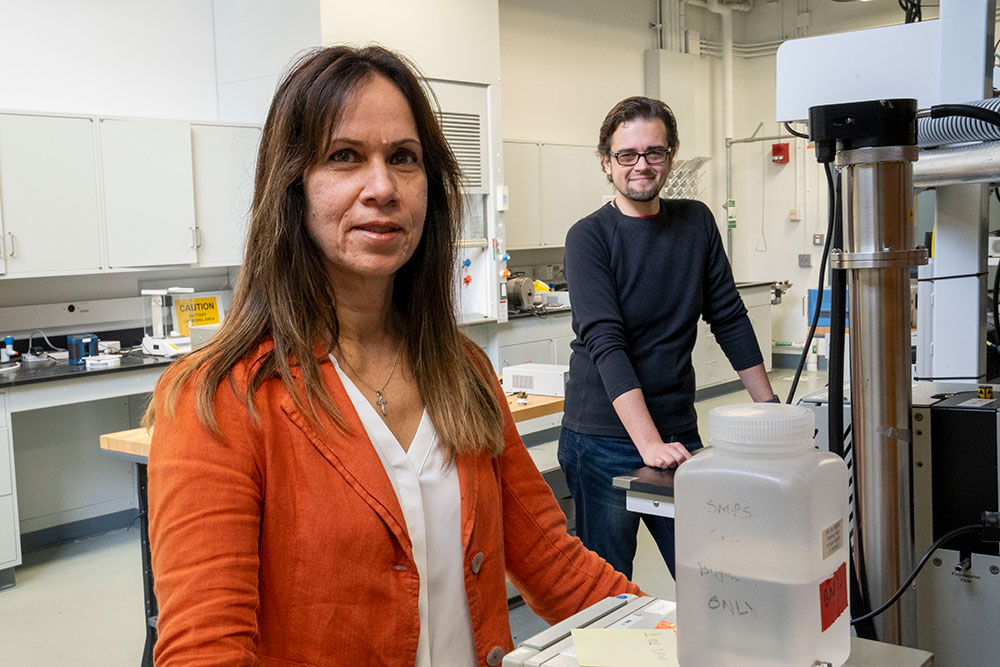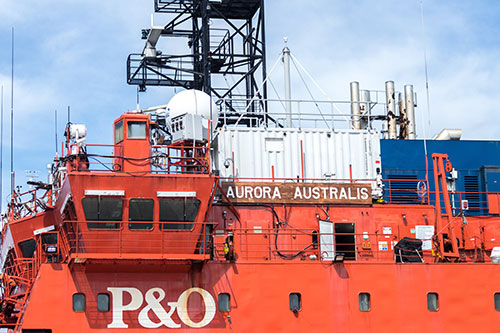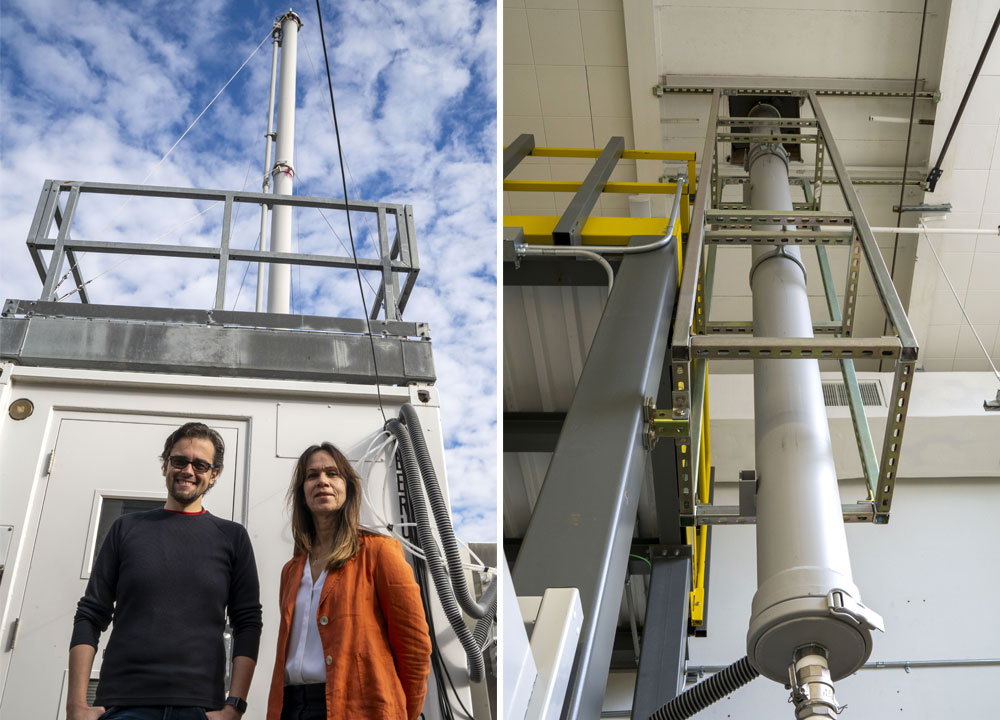Can they Calibrate it? Yes, they CAMS
Scientists are establishing a new Center for Aerosol Measurement Science to increase the accuracy of aerosol measurements used in weather and climate models.
November 6, 2023
 enlarge
enlarge
Olga Mayol-Bracero (left) and Janek Uin (right) in the main Center for Aerosol Measurement Science (CAMS) lab at Brookhaven National Laboratory where aerosol instrumentation will be calibrated to top-tier reference standards.
Scientists at the U.S. Department of Energy’s (DOE) Brookhaven National Laboratory are establishing a facility to improve the accuracy of instruments used to study aerosols—small solid or liquid particles suspended in Earth’s atmosphere. Called the Center for Aerosol Measurement Science (CAMS), this facility will house reference standards for key aerosol measurements to help scientists from across the Western Hemisphere calibrate their aerosol instrumentation.
Aerosols often evoke thoughts of hairspray or spray paint, but there is more to the story. Humans create aerosols during their daily activities, for example, when driving cars that release exhaust or by generating electricity via fossil fuel combustion. Salt particles propelled into the air by waves crashing onto the shore, pollen that blows around on a breezy day, and mineral dust particles swept up by winds from deserts are also atmospheric aerosols, but these are emitted by natural sources.
These microscopic particles, no matter their origin, can have big impacts. While some aerosols provide nutrients to terrestrial and marine ecosystems, they can also change Earth’s weather patterns by altering rainfall and decreasing visibility. In the realm of human health, they can irritate the eyes, nose, and throat—and even cause extensive lung damage. Scientists, however, are still grappling with the intricacies of how aerosols impact Earth’s climate.
“We know that aerosols offset the warming of our planet by scattering light in most cases, but some aerosols can absorb sunlight and contribute to the heat. Aerosols are also critically important in cloud processes. To get a better understanding of these effects, we need precise measurements,” said Brookhaven Aerosol Observing Systems (AOS) group leader Olga Mayol-Bracero of the Lab’s Environmental and Climate Sciences Department (ECSD). “We cannot get these measurements right without well-calibrated instrumentation.”
Standardizing Global Measurements
To put together pieces of the aerosol puzzle, atmospheric scientists supporting DOE’s Atmospheric Radiation Measurement (ARM) user facility deploy AOS units—large white trailers full of complex sampling equipment—to sites from the tropics to the Arctic. Equipment inside each modified shipping container unit measures physical, optical, and chemical properties of aerosols drawn into the AOS unit from the atmosphere outside via a 10-meter-high sampling stack.
Scientists contributing to this global mission have to ensure that the instruments housed in the mobile AOS units are providing accurate and consistent data. One way to do this is to periodically compare the measurements taken with AOS instruments to those taken by reference instruments, like those housed at CAMS. The CAMS instruments will be carefully maintained to stay in excellent operating condition and regularly checked against reference instruments at the World Calibration Centre for Aerosol Physics (WCCAP) in Leipzig, Germany. CAMS scientists can then “tune” the sensitivity and other parameters of the mobile AOS instruments so they produce the same results as the reference instruments. This calibration ensures that all measurements can be traced back to a set of well-maintained reference standards.
“We all rely on calibrations in our everyday lives,” Mayol-Bracero explained. “We expect that the tire pressure gauge we use to measure the pressure of our car tires is properly calibrated. If it is not, we could get incorrect readings, which would change how much air we put in our tires. This can increase wear on the tires, reduce their traction, and increase the possibility of a car accident.”
Similarly, scientists expect their AOS equipment to be calibrated so they can take correct readings anywhere in the world and come to meaningful conclusions.
Though several national laboratories manage and operate ARM, a DOE Office of Science user facility, Brookhaven is a significant contributor to the aerosol science research and ARM AOS operations. As such, Brookhaven is uniquely positioned to lead CAMS, where aerosol calibration standards will reside.
“The expertise in aerosol measurement and research is at Brookhaven Lab,” said Mayol-Bracero, who will serve as the director of CAMS. “It has been here for decades.”
Janek Uin, an ECSD scientist and atmospheric instrument expert—who discovered his passion for aerosol measurements as a young physicist—will serve as the operations lead of CAMS.
“I actually helped build a somewhat smaller calibration lab from the ground up earlier in my career,” Uin recounted. “I am so excited to build one here, especially with all the resources that come from a national lab.”
Both Mayol-Bracero and Uin contribute to the ARM AOS operations—Mayol-Bracero is the ARM AOS lead mentor, and Uin is the mentor of several instruments that make up the AOS. Instrument mentors set up and test the AOS equipment before each deployment and ensure optimal operations throughout the experiments.
 enlarge
enlarge
AOS units are deployed all around the world to gather aerosol data. In 2017, Brookhaven scientist Janek Uin served as an instrument mentor for a study that deployed an AOS on the Aurora Australis in the Southern Ocean. (Credit: Janek Uin)
Uin has served as an instrument mentor for deployments on ships locked in Arctic ice and crossing the Southern Ocean (the stormiest ocean on Earth). But after years of adventurous research campaigns, he is eager to expand his role at Brookhaven and connect to his calibration roots through his work at CAMS.
“It was fun to solve difficult problems in different situations,” Uin remarked. “I got to see how the instruments operated in extreme conditions that even the instrument manufacturers could not have experienced. It was like taking a finely tuned Porsche to go off-roading.”
“My time spent working with aerosol equipment in a variety of climates all over the world really helped me understand how the instruments function,” he added. “I’m excited to apply this knowledge to my work at CAMS.”
A “Home Base” in the United States
Before an ARM deployment, scientists will be able to send their AOS equipment to Brookhaven for calibration to the reference instrumentation. With equipment calibrated to top-tier reference instruments, scientists will be able to collect higher-quality data. These improved data sets will ultimately help build more accurate models for predicting weather and climate.
“We need a calibration center here in the United States,” Mayol-Bracero explained. “We have our calibration protocols, but there is no facility here with dedicated reference instruments against which others can be calibrated.”
She noted that European scientists recognized a need for calibration services over two decades ago. In 2002, they established WCCAP, the calibration facility in Leipzig, as part of the Global Atmosphere Watch program of the World Meteorological Organization. For two decades, WCCAP has been the only calibration center for equipment that measures the physical and optical properties of aerosols in their natural environments. Scientists seeking calibration either had to ship their equipment across continents and oceans to Germany or pay hefty prices for independent vendors.
Brookhaven scientists are in the process of setting up the main CAMS lab and plan to start operating the facility for ARM instrument calibrations sometime in 2024. As the soon-to-be second facility of this kind, CAMS will be a game-changer for those conducting aerosol research in the Western Hemisphere. With reference standard instrumentation at Brookhaven Lab, more scientists will have an accessible calibration center to help address questions regarding measurement or equipment accuracy.
“CAMS will run independently,” noted Mayol-Bracero. “But we plan on learning from what the scientists at the WCCAP have accomplished thus far.”
 enlarge
enlarge
Uin and Mayol-Bracero stand outside an Aerosol Observing System (AOS) unit at Brookhaven Lab (left). The inlet tube on top extends 10 meters into the air and draws in atmospheric samples to be analyzed by instruments inside. The main CAMS lab has a replica of the inlet stack (right) that guides air to aerosol instrumentation in the lab. The scientists use these reference measurements to calibrate the mobile AOS equipment.
A Glimpse Inside
The main CAMS lab at Brookhaven has a replica of the AOS inlet stack, but it is located in a building rather than a mobile trailer. The long inlet protruding from the roof guides samples of outside air from Brookhaven’s Long Island, New York, campus through stainless steel tubes to the instruments that measure key aerosol properties—particle number, concentration, and size.
Scientists studying aerosols’ chemical composition, optical properties, microphysical properties, and hygroscopicity—how much moisture they absorb—will also contribute to the CAMS mission through five additional ECSD labs comprising the facility.
Once CAMS is established and running for ARM users, the Brookhaven team plans to offer calibration services to a larger community of scientists from other measurement and monitoring programs.
“We already have scientists coming to us and asking if we can calibrate their instruments,” Mayol-Bracero remarked. “There are scientists who are unable to ship their equipment to Europe for calibration, so CAMS will make a huge difference in the accessibility of these services.”
CAMS scientists also plan to expand their scope of work to include conducting experiments that contribute to the field of aerosol measurement science.
“We want to provide a research facility where scientists can characterize aerosol properties using cutting-edge instrumentation and address outstanding measurement science questions,” Mayol-Bracero said.
For example, black carbon, a type of aerosol emitted from wildfires and other sources of combustion, contributes to global warming because it absorbs light and traps heat in the atmosphere. Instead of measuring black carbon concentration directly, scientists use filter-based measurements because they are robust and more economical. This technique makes use of black carbon’s light-absorbing properties to infer the concentration by looking at how the light intensity changes as it passes through a filter on which black carbon particles are trapped. But the fibers that make up the filter and other aerosols in the mix can also scatter light and contribute to a reduction of light intensity. This can cause an over-estimation of black carbon concentrations and skew scientists’ understanding of black carbon’s impact on climate.
To improve these black carbon measurements, ARM users have proposed an experiment to be conducted at CAMS. Known as the Absorption Measurement Intercomparison and Calibration Experiment, it will directly compare filter-based black carbon measurements to a reference from other aerosol absorption instrumentation. This will enable scientists to figure out how filter artifacts and other aerosol particles alter the data collected in the field, so they can correct for this when analyzing the black carbon field data.
“Through instrument calibration for field studies and targeted laboratory measurements, CAMS will reduce the uncertainty in aerosol measurements,” said Mayol-Bracero. “These improved measurements will provide scientists with better data for climate models and set the stage for more accurate aerosol research in the future.”
Renovation of the laboratory space was provided by Brookhaven National Laboratory’s institutional infrastructure funds. Funding of CAMS operations will be provided by DOE’s Office of Science as part of the ARM user facility.
Brookhaven National Laboratory is supported by the Office of Science of the U.S. Department of Energy. The Office of Science is the single largest supporter of basic research in the physical sciences in the United States and is working to address some of the most pressing challenges of our time. For more information, visit science.energy.gov.
Follow @BrookhavenLab on social media. Find us on Instagram, LinkedIn, Twitter, and Facebook.
2023-21429 | INT/EXT | Newsroom









